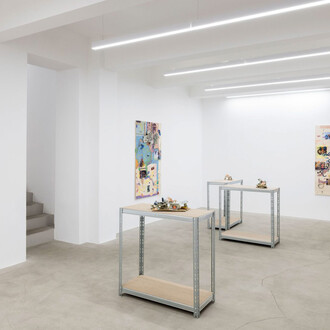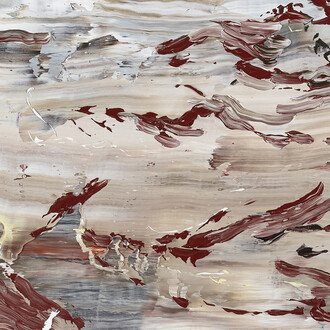kaufmann repetto Milan is pleased to present Humans and expression, a solo exhibition by Japanese artist Keiji Ito.
Born in 1935 in Toki, Gifu Prefecture — an epicenter of Japanese ceramic tradition — Ito has spent a lifetime traversing the boundaries between painting and ceramics, object and artistry. His works, whether oil on canvas or fired clay, are guided less by style than by stance: a practice grounded in restraint, care, and elemental attention.
At the core of this exhibition is a group of intimately scaled ceramic figures that reflect Ito’s long-standing fascination with the human face. The Face series, which emerged alongside his return to painting in his seventies, marks a shift in his practice — from works concerned with external relations and formal clarity to those that dwell in the psychological and emotional terrain of lived experience. These faces, torsos, and crouching bodies carry no explicit expression, yet their stillness is anything but empty.
This return to figuration is echoed in Ito’s recent paintings. Works such as Figure in an apron, Woman, and House present figures through subtle silhouettes and distilled gestures. Their posture and restraint echo the ceramic works in tone, but the brushwork introduces a different rhythm — one that is quiet, soft-edged, and deeply felt. The paintings and sculptures do not mirror each other; rather, they form a parallel vocabulary — emotional before descriptive, observational without distance.
The quiet complexity of Ito’s work also finds a natural counterpart in the Japanese aesthetic of shibui: a subdued elegance in which simplicity becomes a vessel for layered perception. Works like Crouching, Embrace, and Silence embody this quality — not simply in their form, but in their way of being. With their bare, tactile surfaces and rounded contours, they invite contemplation without demanding interpretation. Firing plays a central role in this process. Ito embraces the unpredictability of the kiln, where clay becomes more than shape — its surface altered by flame, ash, and time. The fire introduces effects beyond the control of the hand, a vital step in bringing human presence into the work. For Ito, this transformation is essential: it allows the material to speak for itself.
The soil he uses carries a similar resonance. In his hands, it is not just substance but memory — absorbing both the attention of the maker and the gaze of the viewer. Over time, self-consciousness gives way to something quieter, something closer to stillness or prayer. The result is not expression in a conventional sense, but a holding of presence — an object that seems to breathe without moving. Despite his legacy as a ceramics pioneer in postwar Japan, Ito remains remarkably unselfconscious in his approach. “There is no real boundary between ceramics and canvas,” he has said. Both are ways of thinking through form, of attending to the invisible rhythms of being. His work gestures not toward narrative or symbolism, but toward what it feels like to simply be. Humans and expression is not a declaration. It is a murmured invitation — to pause, to look closely, to be met by a presence that doesn’t ask to be understood. It asks for attention, not interpretation.
















